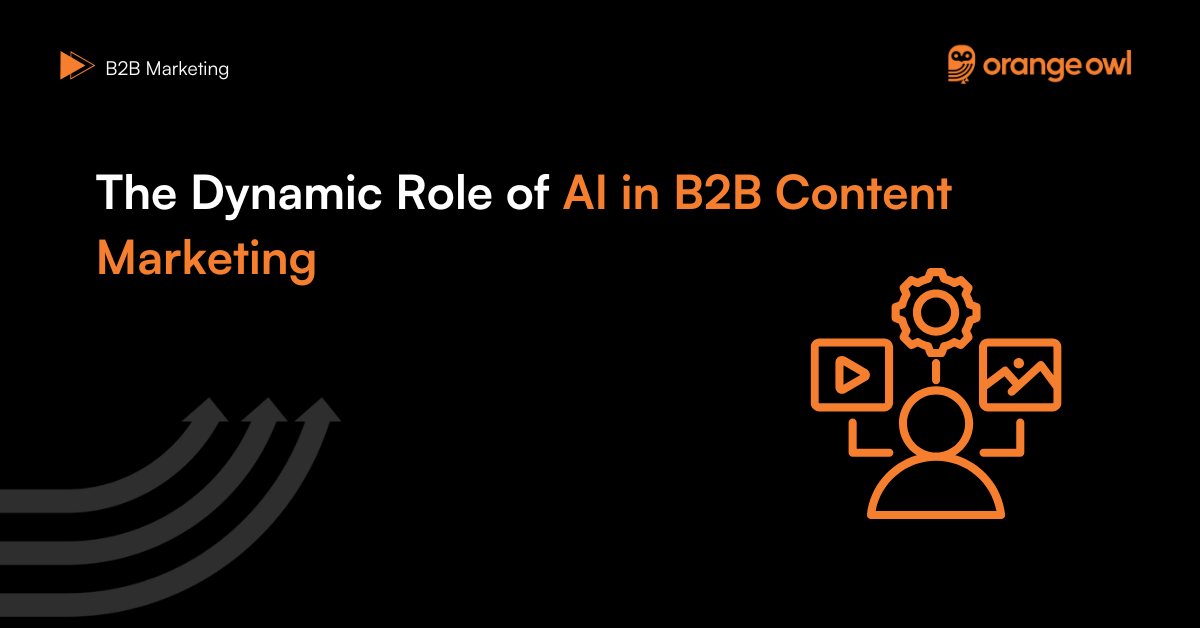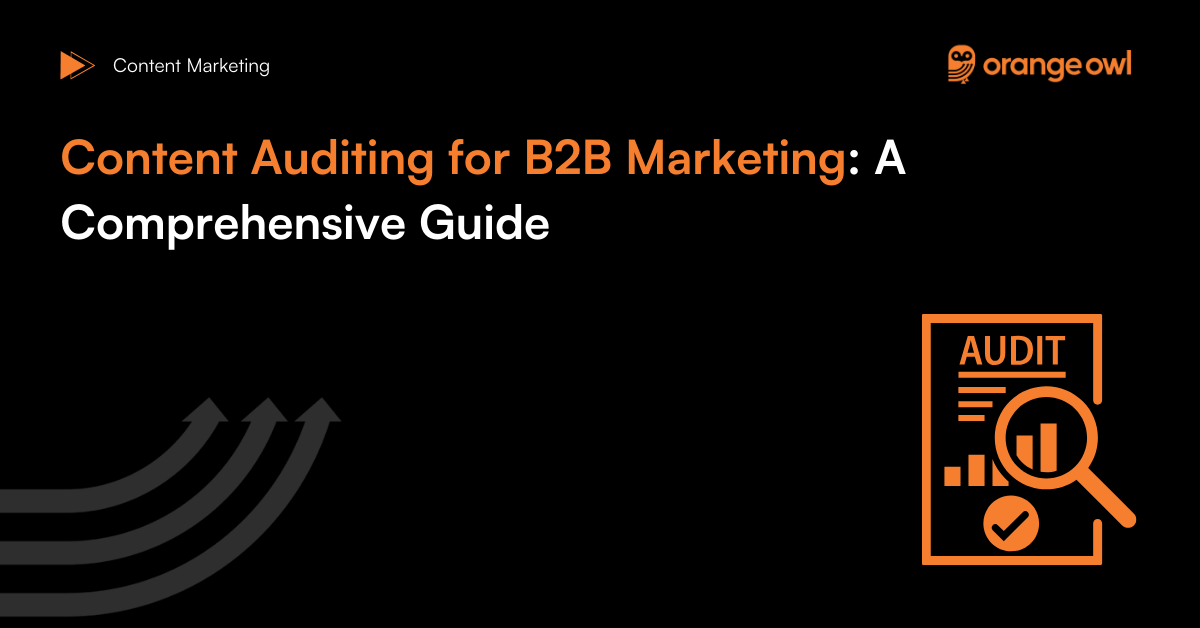100+ Top B2B Content Marketing Statistics You Must Know in 2025
Vivek Goel
June 13, 2024

Table of Contents
In today’s digital landscape, B2B content marketing reigns supreme. It has become essential for companies aiming to engage, inform, and convert their target audience. As businesses strive to stand out in a crowded market, understanding the latest trends and statistics in B2B content marketing can provide invaluable insights. This blog post delves into the top 100 B2B content marketing statistics highlighting the effectiveness, challenges, and opportunities within this dynamic field. These statistics will equip you with the knowledge to refine your strategies and achieve greater success.
 Source: Content Marketing Institute[/caption]
Source: Content Marketing Institute[/caption]
What is B2B Content Marketing?
B2B content marketing involves creating and distributing valuable, relevant, and consistent content to attract and retain a clearly defined audience, ultimately driving profitable customer action.
Unlike B2C marketing, which targets individual consumers, B2B content marketing focuses on engaging other businesses. This approach often includes various content formats such as blogs, whitepapers, case studies, webinars, and videos designed to address the specific needs and pain points of business professionals and decision-makers.
Top 7 Benefits of B2B Content Marketing
- Increased Brand Awareness: High-quality content helps establish your brand as a thought leader in the industry, making it more recognizable and trustworthy.
- Lead Generation: Effective content attracts potential clients by addressing their needs and providing solutions, leading to higher conversion rates.
- Customer Engagement: Regularly updated and relevant content keeps your audience engaged, fostering stronger relationships and customer loyalty.
- SEO Benefits: Consistent content creation improves your search engine rankings, driving organic traffic to your website.
- Cost-Effective: Content marketing is often more affordable than traditional marketing methods and yields higher returns on investment.
- Educates and Informs: Providing valuable information helps your audience make informed decisions, positioning your business as a reliable resource.
- Supports Sales Efforts: Well-crafted content can assist the sales team by addressing common objections and highlighting the benefits of your products or services.
Top Content Marketing Statistics
Content marketing for B2B differs from B2C, but it ultimately targets people. Let’s dive deep with over 100 stats categorized for your B2B content marketing success.
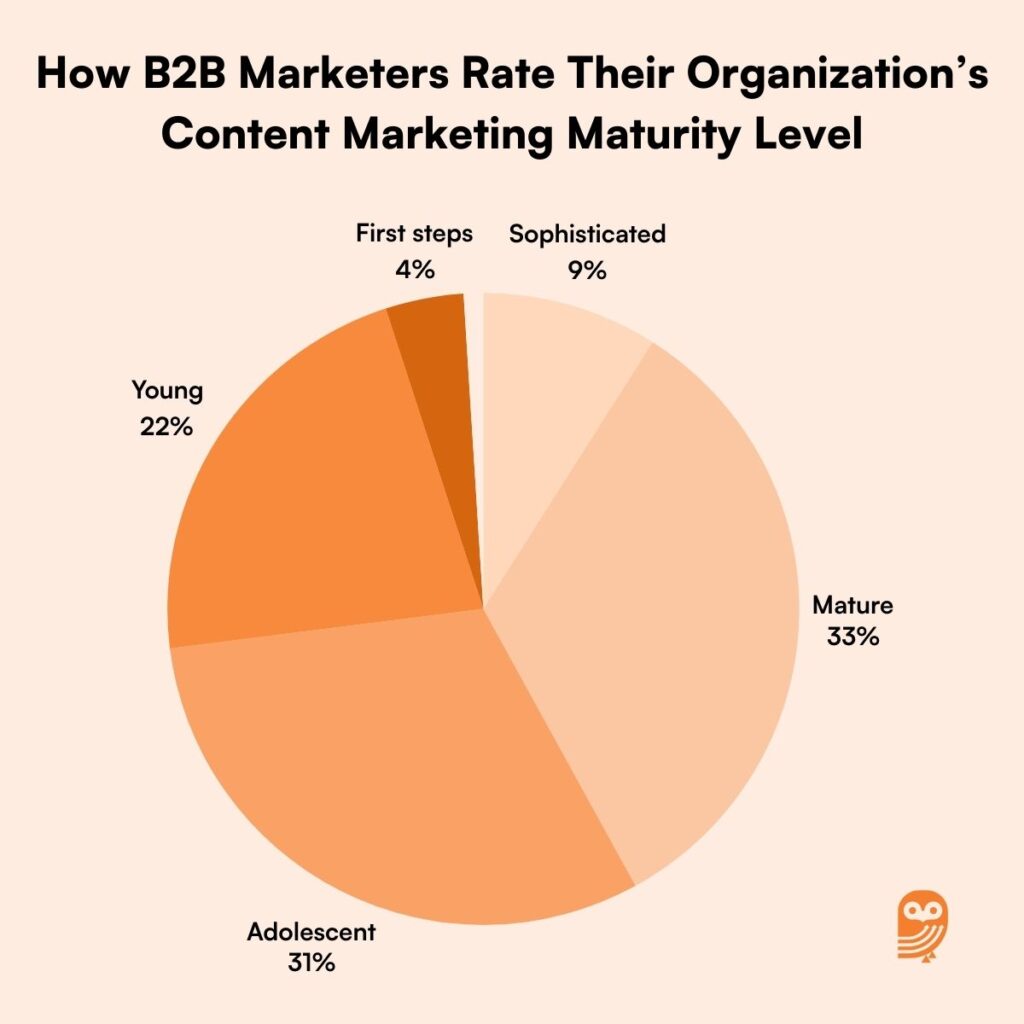 Source: Content Marketing Institute
Source: Content Marketing Institute
- Most marketers publish new content several times weekly. B2B content marketing is a consistent effort.-Databox
- It takes 3 hours and 51 minutes to write a blog post. Writing high-quality B2B content takes time and effort.-Orbit Media
- The most successful B2B marketing teams allocate 40% of their budget to content marketing.-Emarketer
- 93% of content on B2B sites doesn’t receive links from other websites.-Backlinko
- In 2019, 84.5% of American companies with 100+ employees used digital content marketing, and 87% of B2B companies did the same.-Emarketer
- The five most popular content distribution channels for B2B marketers are email (93%), social media (92%), blog posts (79%), in-person events (56%), and virtual events/webinars (55%). The most successful B2B companies use all five formats, while less successful ones use only four.-CMI
- Only 42% of B2B content marketers conduct audience research by directly speaking with customers.-ContentMarketingInstitute
- 66% of B2B marketers use paid channels to distribute content- Search Engine Watch
- 60% of customers consider purchasing a product after reading content about it.-Demand Metric
- The content marketing industry was projected to grow from $26.5 billion in 2014 to $50 billion in 2019 and is now expected to reach $105.28 billion by 2025.-Grand View Research
- 92% of B2B and B2C marketers consider their content the most valuable marketing asset.-Content Marketing Institute
- Content marketing generates three times as many leads as traditional marketing while costing 62% less.-Demand Metric
- 76% of people expect brands to enhance their well-being and quality of life, but 58% of content provided is deemed hollow and meaningless. –Meaningful Brands
- The most outsourced content marketing activities are writing (44%) and graphic design (41%). – Best Writing
- 62% of B2B decision-makers prefer consuming content on desktops or laptops.
- 63% of respondents go directly to a company’s website for information.-Isoline Comms
- 67% of B2B content teams say top-of-funnel content is the type of content they create most –Databox
- 65% of B2B buyers say they find short-term content (blog posts, infographics) most appealing to them-Demand Gen Report
- B2B blog posts are getting longer. On average, content ranking on the first page of Google tends to be around 1,447 words–Backlinko
- 81.5% of B2B content marketers plan to implement AI tools in 2025.-Siegemedia
- Virtual events produced the best results for B2B marketers in 2023, with 47% of content marketers reporting strong outcomes.-Content Marketing Institute
- 63% of content marketers use their content strategy to build loyalty with their existing clients.-Content Marketing Institute
- Only 66% of B2B marketers frequently prioritize their audience’s needs over their sales message when creating content. Of the most successful content marketers, 88% do.-Content Marketing Institute
- 47% of B2B marketers don’t measure ROI from their content marketing efforts.-Point Visible
- 42% of B2B marketers say their organization is in the sophisticated/mature phase of content marketing maturity.-Content Marketing Institute.
- 40% of marketers who use automation leverage chatbots.-Hubspot
- The majority (80%) of B2B decision-makers prefer learning about a potential vendor through content-like articles.-WBResearch
- 52% of B2B buyers are “definitely” more inclined to make a purchase after viewing content.-Marketing Charts
- Content marketers reported using AI tools to generate content (47%) and design elements (28%).-Siege Media+Wynter
- 71% of content marketers reported using AI tools to help with content ideation, such as brainstorming keywords.-Siege Media+Wynter
- 36.7% of marketers report that creating engaging visual content consistently is one of their top struggles.-Venngage
- 83.2% of content marketers plan to use AI tools in 2025, a nearly 30% from 2023 at 64.7%.-Siege Media+Wynter
- 62.3% of content marketers reported creating interactives as being a part of their content marketing strategy.-Siege Media+Wynter
- Only 12% of marketers are currently using voice search tactics as part of their strategy.- Hubspot
B2B Marketing Teams
Understanding how B2B companies manage their marketing activities (in-house vs. outsourced) helps determine industry trends and resource allocation strategies.
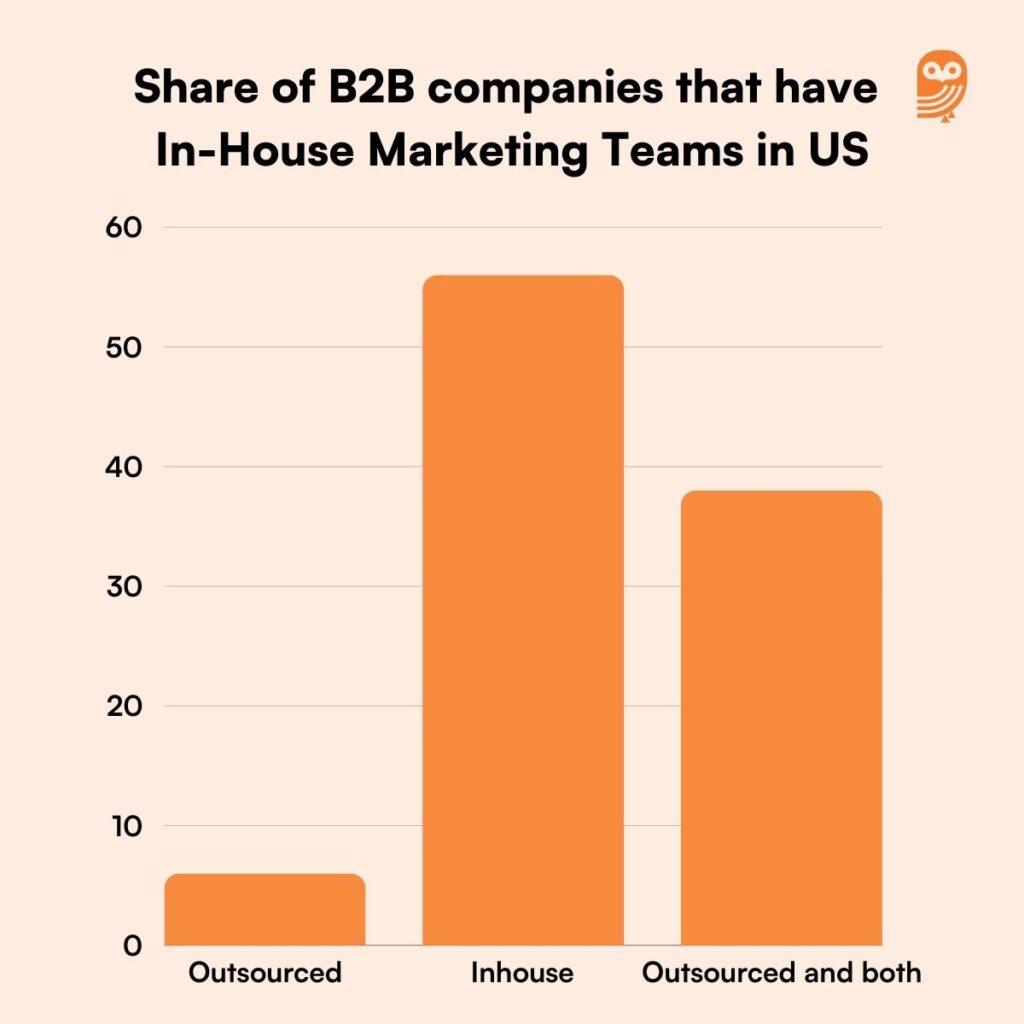 Source: Statista
Source: Statista
- 41% of B2B businesses conduct their marketing activities in-house.To fill the gaps, most B2B companies seek assistance with tasks like keyword research, content creation, and ad management-Statista
- Half of B2B marketing teams outsource at least one content marketing activity.The level of B2B content marketing outsourcing varies by company size. Large companies leverage outsourcing the most (75%), followed by medium (54%) and small companies (37%)- Content Marketing Institute
- 84% of those who outsource cite content creation as the activity they get the most help with-Content Marketing Institute
B2B Marketing Budgets
Knowing how much B2B organizations typically spend on marketing helps with budget planning and understanding where competitors might be focusing their efforts.
- 33% of B2B content marketers expect to increase their digital event budgets.-Content Marketing Institute
- On average, B2B organizations allocate 9.7% of their total budget to marketing.B2B marketing budgets are typically smaller than B2C budgets-CMO Survey
- 54.5% of businesses plan to spend more on content marketing in 2025 than in 2023.-Siege Media+Wynter
- 47.6% of businesses plan to spend $5K to $25K on content marketing in 2025.-Siege Media+Wynter
- A business spending over $4,000 or more per post is about 2.6 times more likely to have a “very successful” report than those who spend $0-$500.-Siege Media+Wynter
- B2B businesses devote an average of 33% of their marketing budget to content marketing.-SmartInsights
- 45% of B2B companies plan on increasing their content marketing spend within the next 12 months.Content marketing is a growing area of investment for B2B companies-Content Marketing Institute
- 69% of B2B marketers plan to increase their investment in video marketing in 2025.Video marketing is an increasingly popular B2B marketing tactic- CMI
- Digital ad spend is expected to soar to $645.8 billion by 2025, with a significant portion likely directed towards B2B marketing efforts like LinkedIn ads, sponsorships, and Google Ads-eMarketer
B2B Lead Generation Statistics
These statistics shed light on the effectiveness of content marketing in generating brand awareness for B2B companies.
- Lead conversion is a key metric for 73% B2B marketing campaigns –CMI
- Content marketing helps with brand awareness for B2B companies Top-of-the-funnel content is most popular (67%) for B2B content marketing-CMI
- The average conversion rate from marketing qualified leads (MQLs) to sales qualified leads (SQLs) is low i.e 13% –Implisit
B2B Video Marketing Statistics
These statistics showcase the growing importance of video as a format for B2B content, as it resonates well with B2B buyers for product research.
- More than half of tech buyers find video the most useful form of content . While most people in B2B traditionally think of content as text-based (like blogs, reports, and case studies), B2B buyers often prefer video content. –Isoline Comms
- Approximately 90% of B2B buyers watched a video to learn about products or services in the past three months- Search Engine Journal
- 64% of B2B buyers report that podcasts were helpful at the beginning of their buying journey.-Demand Gen Report
- Most companies with video marketing strategy (49%) use a mix of in-house and agency-created production to create their videos.-Hubspot
B2B Blogging and SEO Statistics
Understanding how B2B buyers find information online helps with optimizing B2B websites and content for search engines. SEO writing and blogging remain essential despite the rise of videos and social media.
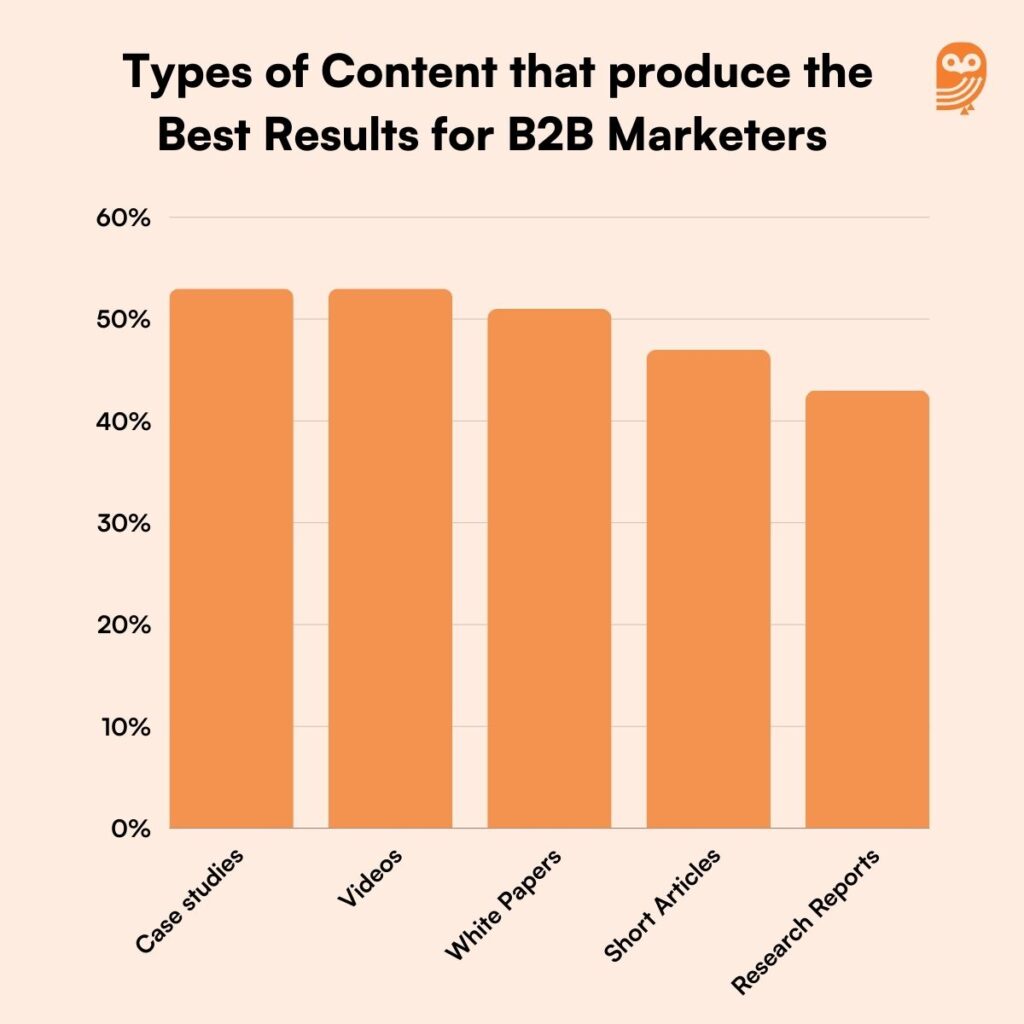 Source: Content Marketing Institute
Source: Content Marketing Institute
- The majority (66%) of B2B buyers in the US discover products through internet search results,rather than relying on industry publications or attending trade shows- Statista
- 50% of B2B e-commerce companies prefer blogging as their primary marketing strategy.-Siegemedia
- 51% of content consumption derives from organic search.-Kuno Creative
- 56.4% of content marketers who use a link building strategy report rely on organic link generation rather than manual outreach.-Siege Media+Wynter
- In 2020, two-thirds of Google searches ended without a click.-SparkToro
- Respondents consume an average of 4.5 pieces of content before contacting a supplier. –Isoline Comms
- B2B companies with consistent blogging generate 67% more monthly leads compared to those that don’t.-Demand Metric
- 52% of B2B marketers consider blogging crucial for content marketing success-Content Marketing Institute
- 59% of B2B marketers view blogs as the most valuable channel.- Demand Metric
- It takes 3 to 5 pieces of content before 40% of B2B buyers reach out to a seller.-Demand Gen Report
- 75% of B2B marketers use blogging for social media content, compared to 61% of B2C marketers.-Social Media Examiner
- The average B2C blog post receives 9.7 times more shares than a blog published on B2B sites. – Backlinko
- Only 2% of articles by B2B brands account for 75% of social shares.-Backlinko
- A staggering amount (60-70%) of B2B marketing content is never used.-Forrester
- In 2020,the number of bloggers exceeded 31.7 million.-Statista
- Blogs with relevant images receive 94% more views.-Mdgsolutions
- 68% of B2B and B2C marketers responded that they plan to add more images in the future.-Mdgsolutions
- On an average, it takes a blogger about 3 hours and 16 minutes to write an average-sized blog post.-Orbit Media Solutions
- Bloggers spending around 6 hours on a post are 56% more likely to see better results.-Orbit Media Solutions
- 50% of bloggers who write Long-form blog posts are more likely to expect better content marketing results–Orbit Media Solutions
- 36% of readers prefer articles with numbers in the headlines.-CXL
- 29% of Google users only visit one page from the search resultsB2B buyers .tend to click on a single search result to find their solution quickly, reflecting their preference for efficiency-Backlinko
B2B Email Marketing Statistics
This category highlights the effectiveness of email marketing for B2B content distribution.
- According to 39% of respondents, email newsletters are the most effective distribution channel for B2B marketers.Subscribers are typically loyal and close to making a purchase-Content Marketing Institute
- 77% of B2B companies and agencies include email newsletters as a key component of their content marketing strategy.-Content Marketing Institute
- 89% of all B2B emails use the company name as the sender-SuperOffice
- Personalized subject lines in email outreach increased the unique open rates by 27% and lead to an 11% higher click-to-open rate.-Experian Marketing Services
- For every $1 dollar marketers spend on email marketing, they receive an average ROI of $42.-Litmus
- Email marketing revenue worldwide is reported to be more than $8,490,000,000.-Statista
B2B Social Media Statistics
Social media is a key strategy in B2B content marketing.Knowing which social media platform (e.g., LinkedIn) is most valuable for B2B companies, helps with prioritizing social media efforts.
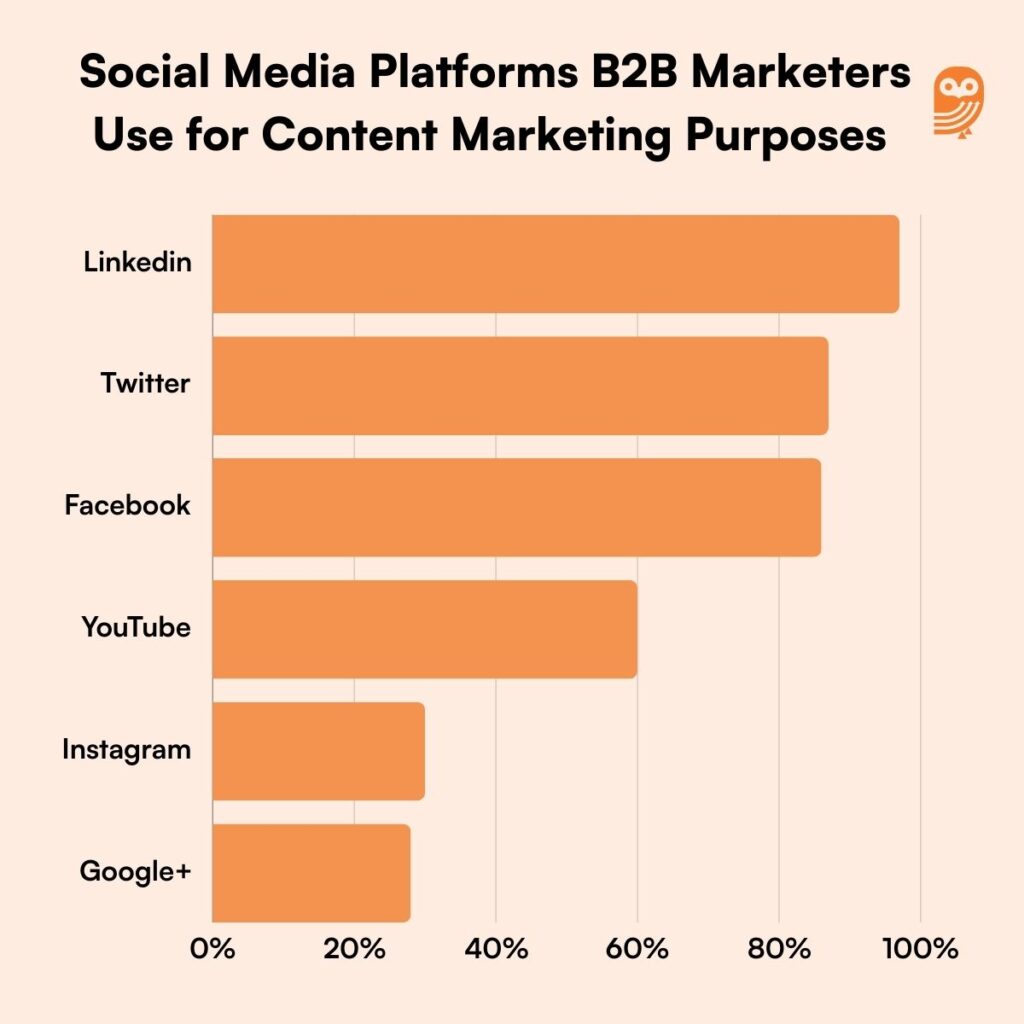 Source: Content Marketing Institute
Source: Content Marketing Institute
- 90% of B2B marketers have used social media platforms for content distribution in the last 12 months, making it the most widely-used channel. Platforms like LinkedIn and Twitter play a crucial role in influencing buyers through various forms of content and discussions-Content Marketing Institute
- Social media ranks as the third most effective content type for B2B marketers (41%). –Content Marketing Institute
- Over 70% of B2B marketers report improved sales after using social media for 12 months.-Social Media Examiner
- Experts predict Twitter Spaces will be a growing area of audio investment.-Social Media Examiner
- 45% of B2B marketers measure success through social media shares.-Demand Metric
- 60% prioritize web traffic, and 51% focus on sales lead quality over social media shares.-Demand Metric
- People spend about 2.5 hours daily on social media.-GWI
- Facebook users recall content after seeing it just for 0.25 seconds.-Meta
- Facebook users spend 1.7 seconds on each piece of content.-Meta
- 58% of customers prefer visual content on social media than written posts.-Sprout Social
- 59% of consumers seek educational posts.-Sprout Social
- Increasing brand awareness is the main goal for 80% of social media marketers.-Sprout Social
- 84% of B2B buyers regularly share business-related content on LinkedIn.
- 78% of B2B marketing companies find LinkedIn the most effective platform, followed by Twitter (48%) and Facebook (42%).-Content Marketing Institute
- Social media is the top channel for achieving both top-of-funnel and bottom-of-funnel goals. About 50% of B2B marketers find social media most effective for top-of-funnel goals, and 46% for bottom-of-funnel goals-Wpromote
- 82% of B2B marketers consider LinkedIn the most valuable social media platform. LinkedIn’s professional focus makes it a key platform for B2B marketing strategies, from publishing content to engaging with target audiences-Content Marketing Institute
B2B Marketing Analytics Statistics
Understanding how B2B marketers measure their success helps determine industry benchmarks and identify key performance indicators (KPIs) for B2B marketing campaigns.
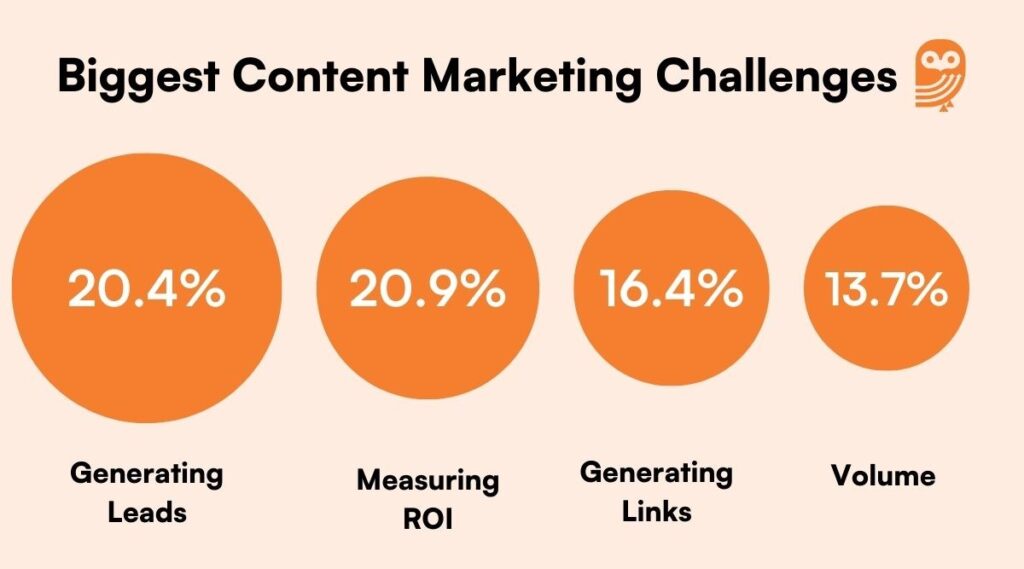 Source: Seigemedia+Wynter
Source: Seigemedia+Wynter
- While 74% of marketers set goals, only 50% achieve them always or most of the time. – CoSchedule
- Conversions are the most common metric for evaluating content performance. Other important metrics include email engagement, website traffic, and website engagement, all cited by 73% of marketers. – Content Marketing Institute
- On average, marketers use 18 data sources for reporting. This includes CRMs, Facebook Ads dashboards, revenue figures, and more, ensuring a comprehensive analysis beyond just Google Analytics. – Salesforce
Conclusion
B2B content marketing is a powerful tool that can significantly impact your business’s growth and success. By leveraging the right strategies and understanding the latest trends and statistics, you can create compelling content that resonates with your target audience. The top 100 B2B content marketing statistics we’ve explored in this blog highlight the importance of a well-rounded content strategy that includes diverse formats, continuous audience engagement, and effective distribution channels.
Investing in content marketing not only increases brand awareness and lead generation but also enhances customer loyalty and boosts your SEO efforts. As the digital landscape continues to evolve, staying informed and adaptable will ensure your content marketing efforts remain effective and yield impressive results. Embrace the power of content, and watch your B2B business thrive in an increasingly competitive market.
FAQs
Measuring ROI involves tracking key performance indicators (KPIs) such as lead generation, conversion rates, website traffic, engagement metrics, and sales impact. Tools like Google Analytics, CRM systems, and marketing automation platforms can help.
Small B2B businesses can focus on creating high-quality, niche-specific content, leveraging social media, optimizing for SEO, engaging in guest blogging, and using email marketing to build relationships and nurture leads.
Align content marketing with business goals by setting clear objectives, understanding your target audience, creating a content calendar, and regularly reviewing performance metrics to adjust strategies as needed.
ABM involves creating personalized content for specific target accounts, aligning marketing and sales efforts, and using data-driven insights to tailor messages that resonate with key decision-makers within those accounts.
Encourage customers to share their experiences, case studies, and testimonials. Share UGC on your website, social media, and email campaigns to build credibility and trust with potential clients.
Tools like Google Analytics, HubSpot, SEMrush, and content management systems (CMS) like WordPress can help with content creation, distribution, and performance tracking. Marketing automation platforms can streamline processes.
Use gated content like whitepapers and eBooks, host webinars, offer free trials or demos, and use call-to-action (CTA) buttons on your website and blog posts to capture leads.
Analyze metrics like website traffic, engagement, conversion rates, and lead generation. Use insights to identify successful content, understand audience behavior, and make data-driven decisions to refine your strategy.
Case studies demonstrate real-world success and build credibility. They provide detailed examples of how your products or services solve specific problems, helping potential clients visualize the benefits.
Follow industry blogs, attend webinars and conferences, join professional networks, and subscribe to newsletters. Engage with thought leaders on social media and participate in relevant online communities.

